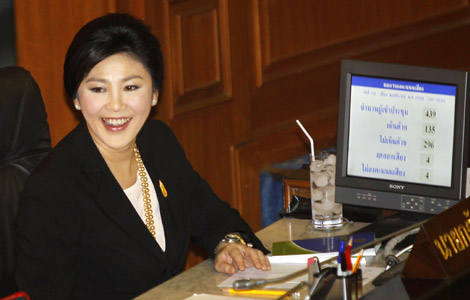
Regulations strict, say conservationists
Given the surge in poaching in recent years, efforts to combat the illegal trade in elephant tusks have begun to focus on China due to a perception that the country has a large market for ivory products. In 2008, the Convention on International Trade in Endangered Species of Wild Fauna and Flora approved China as a trading partner for the second one-off sale of ivory from Botswana, Namibia, South Africa and Zimbabwe. Later there was a surge in elephant poaching in Africa. From Dec 2 to 4, an African Elephant Summit will be held in Botswana to discuss the issue. Is China to blame for the diminishing number of African elephants? Recently, China Daily reporter Ma Yi interviewed experts on the question.
Has demand for ivory products in the Chinese market grown sharply in recent years?
Wang Shan, secretary general of China Arts and Crafts Association:
There has been a surge in demand for ivory craft, but the rate of increase has been far less than the reported cases of poaching.
Since 2000, there has been a craze for cultural art collecting and we have seen the price of many items rise hundreds of times.
Compared to other collectors' items, like paintings, porcelain, jade carvings, the value of ivory crafts has risen only three to 10 times, depending on the qualities.
In addition, only ivory craft items with certificates can be sold, and their auctions need special approval.
Investors don't like this kind of item in their collections. It is the main reason why the price of ivory craft items is rising more slowly than others.
Moreover, the wildlife agency of the Chinese government has taken strict steps on the legal provision of ivory materials for carving. It is about five tons every year. Only about 80 percent of the legally approved investment of materials has been used for carving in recent years.
The ivory craft market at approved sites is not so good. Ivory craft items from illegal sources won't get the collection certificate, and thereby cannot be traded.
In general, investors won't risk investing much for nothing in future.
From my experience, the illegal sales of ivory craft items are sporadic, and the number is very limited.
Considering the above facts, the scale of illegal sales of ivory craft items is well below the scale of poaching of African elephants, which is thought to be above 20,000 poached every year, and illegal harvested ivory probably exceeds 200 tons.
Even if the government had permitted 5,000 selling sites, I don't believe they could sell so many ivory craft items every year.
Given that there are ivory products from legal sources in the market, how can we be sure that tusks from an illegal source do not find their way onto the legal market?
Jin Yu, professor of national wildlife detecting center at Northeast Forestry University:
The strict monitoring and management measures on the ivory carving industry can effectively prevent ivory products from illegal sources.
It is almost impossible for legal ivory carving factories and selling sites to hide their activities.
The Convention on International Trade in Endangered Species of Wild Fauna and Flora prohibited international trade of tusks in the early 1990s.
From then on, China adopted similar measures on wildlife under national protection to control the trade of ivory products.
In the early 21st century, the existing measures were not enough to curb illegal trade because it was very difficult for law enforcement agencies to identify the legality of ivory products.
In 2004, China introduced a special registration, labeling and certification system for monitoring and managing the ivory carving industry.
It is said that legal carving and the sale of ivory craft items must be conducted at approved sites so that law-enforcement agencies can carry out regular or surprise inspections.
Second, all ivory raw materials must be investigated to confirm legality and be registered or sealed only after they are confirmed to be from legal sources.
Every ivory carving factory must apply for permission for legal raw materials every year and apply for certificates for ivory products.
The National Wildlife Detection Center will check if the products match their raw materials before issuing the certificates. Only ivory products with the labeled certificates can be sold at approved sites and apply for auctions.
Law-enforcement agencies and the public can also check them online after certificates are issued.
The measures ensures that every ivory product with a certificate comes from legal sources and enables law-enforcement agencies to find illegal cases much more easy.
China has revoked approval of four ivory carving factories and 27 selling sites, most of which have been punished through legal channels.
Reported ivory smuggling cases have risen in recent years. Is the market in China an incentive for the illegal ivory trade? What else can we do to better protect elephants?
Zhang Wei, dean of the College of Wildlife Resources of Northeast Forestry University:
The reasons for the rising cases of illegal poaching are many, and curbing the poaching cases requires joint efforts.
There are three legal sources of elephant tusks in China, including pre-convention stockpiles, pre-convention imports from the US and some European countries and imports from four African countries in 2009 with permission of CITES. In 2008, China legally imported 62 tons of ivory products from four African countries. That money is to go to Africa for elephant conservation. Tusks from illegal sources are hard to enmesh in the legal carving and sales system.
China takes strict law enforcement measures to curb illegal ivory trading and severely punish offenders.
However, there are still smuggling activities in China.
One of the reasons is that illegal ivory trading is a whole business chain and needs efforts from all sides.
In some African countries, vendors almost forcibly sell products to Chinese tourists. This makes law enforcement more difficult.
Some cross-border smuggling activities have avoided other countries' supervision and items were confiscated in China.
Also, misleading information about wildlife markets could lead to a subjective judgment on market trend, which directly influences the active supply and then directly causes poaching.
One example is that in the 1980s, driven by rumors that each panda skin was worth more than $1 million abroad, some locals began poaching pandas, but in reality no such market exited abroad.
From 2005 to 2010, when there was talk of legalizing tiger bone sales, the number of illegal trades in tiger products rose rapidly.
I have noted that some reports from NGOs and media exaggerate China's demand for ivory, which possibly drives illegal poaching.
Meanwhile, the international community should help African countries improve patrols. It is the most effective way of stopping poaching. China has started to give it support.
Also, we should further educate the public to know that the illegality of tusk sources is closely related to elephant poaching.
There are around 500,000 African elephants. Every year around 10,000 will die of natural causes.
We believe that if people can handle the relationship between conserving the crocodiles and crocodile trade, they should be able to protect elephants and our traditional carving culture.
This could be a sustainable, reasonable and harmonious process.
Contact the writer at mayi@chinadaily.com.cn

(China Daily Africa Weekly 11/29/2013 page3)








